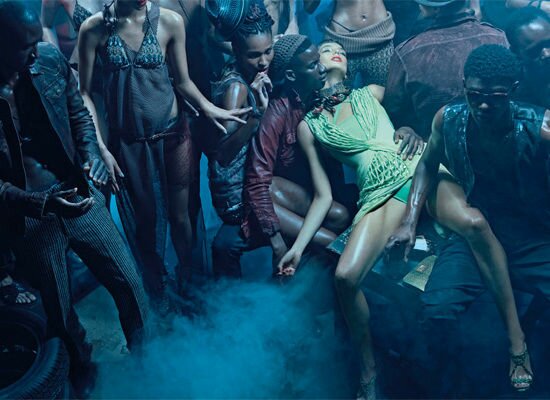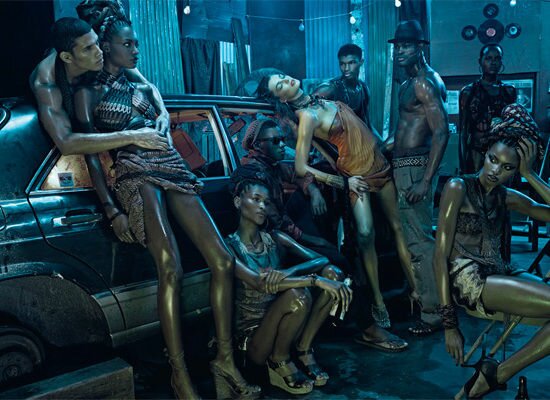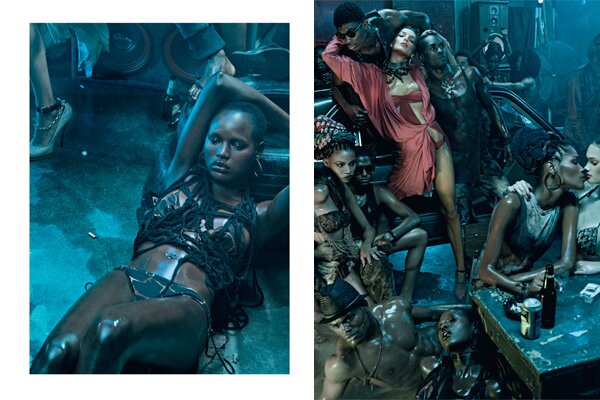Race is Sexy. Sex is Racy. Now “Get Lost”
Race is sexy. And sex is racy. Is it any wonder that our society seems fascinated, obsessed even, with their combination? Consider the latest photo shoot by Mikael Jansson titled Let’s Get Lost, in the current issue of Interview Magazine.
 The photos are edgy. They’re sexually charged, literally (and symbolically) hot and wet. They’re also undeniably racially provocative. The white model (Daria Werbowy) is apparently “Lost”, at least that’s what the title of the spread implies.
The photos are edgy. They’re sexually charged, literally (and symbolically) hot and wet. They’re also undeniably racially provocative. The white model (Daria Werbowy) is apparently “Lost”, at least that’s what the title of the spread implies.
But lost in what?
In the heat of the moment?
Perhaps, but the racial composition is designed to draw attention to itself. Not only is it not coincidental that Daria is surrounded by Black models, it is the central point:
White Daria is lost in a sea of Blackness.
Are such images racist? Refinery29 writer Connie Wang thinks so.
From the differences in their dress (Daria’s in ethereal, angel-like gowns, the others are in knits and leathers) to their body language (A limp yet super-sexual Daria is the main focus, the others feel almost like props), the whole spread has a rather racist vibe that we can’t get down with despite the gorgeous art direction of the spread. Don’t you agree? After all, regardless of what some say, fashion is at its core a political and social product—how power relationships are set up in editorials can speak volumes. So while the super-sexy, ethno-traditional thing is very of the moment, it all seems to be setting up a 21st century colonial construct that makes us very uncomfortable.
Wang’s point about fashion being a political and social product is well taken, but I’m having a hard time resonating with the rest. Sure, everyone surrounding Daria seems like a prop, arranged “just so” in order to make a statement about the (white) featured model. But then (and I say this without any disrespect), aren’t all models essentially “props” — placed, posed, dressed, and later digitally altered in order to make a statement about a product? Is it really the “propping” that makes these shots “racist”?
More to the point, is “Is it racist?” really the best question to ask in this particular case?
Admittedly, I’ve asked this same question more than once myself (here, here, and here). As thought experiments, these blog posts were fun to write, and they are not without redeeming qualities. Yet, I’m becoming increasingly determined to stop framing the discussion in this particular way, because the question itself is off-putting to many and the answer is almost always unsatisfying. How can it be otherwise, when the question presents a dichotomous response choice and demands that we pick one of those responses?
It’s better, I think, to ask: what is the racial impact?
The answer, I think, depends on the individual involved.
To begin with, the sea of Blackness is supposed to be desirable, seductive, inclusive even. “Let’s get lost,” the title says, inviting the audience to join the party and get lost with Daria. The explicit connotations are entirely positive. Blackness here is not something to fear or avoid. It’s something to, well, get lost in, as we might with a good book, or a hypnotic song. Indeed, Let’s Get Lost is also the name of a 1988 documentary film about jazz trumpet player of Chet Baker. It somehow seems worth mentioning that Baker was white.
The inclusivity is not irrelevant, not as long as we continue to live in a society in which the segregation, exclusion, and “othering” of Blackness is commonplace. To dismiss this photo spread as “racist” is to deny that it not only rejects but actively counters the still all-too-prevalent association of Blackness with physical threat and danger.
And yet, it would be naive to pretend that these photographs don’t also perpetuate and exploit another common stereotype: the association of Blackness with hypersexuality. My twitter friend Jo Nubian (@beautynubian) broke it down this way:
I think that these photos clearly promote the hypersexualization and fetishization that sits at the center of our culture. For the most part Black sexual constructs are either over-sexual or asexual. Black women are either mammies or over-sexed whores. Black men are either Uncle Toms or rapers of white women who need to be castrated and lynched. All of these constructs are the remnants of slavery and are the means that Whites used to justify whatever treatment they decided to inflict upon Blacks. The question is what thoughts are conjured by these images in the U.S. today? When I see [these] images, I see a white woman who as @TProlificJones noted, is “lost” in a sea of darkness or corrupting blacks. She almost seems overwhelmed by them and clearly hypnotized without choice.
I think Jo’s framing of the question as “what thoughts are conjured by these images?” is exactly on point. And lest anyone think that Jo’s perception is colored by her own blackness and gender (of course it is!), another Twitter friend, Gordon Katic (@gord_katic), a white philosophy and political science student (boy, that racial modifier feels awkward here) had a very similar perception:
[an] affluent white woman experimenting with blacks in what appears to be a gutter. I think the black models are being condescended to. They’re treated as an exotic sexual experiment.
I agree with both Jo and Gordon, but only to a point.
For anyone familiar with the historical fetishization of blackness, it is simply impossible to not see these photographs against this historical backdrop. Indeed, I am convinced that Mikael Jansson was not only well aware of this backdrop but was using (exploiting?) it to produce the psychological effect he wanted.
Of course, we have no way of knowing what that effect is, and it wouldn’t matter even if we did.
In this way, the project is brilliant, both in conception and execution. The photos are provocative and controversial precisely because different people see them differently, as they must given their own unique life experience.
And that’s the rub: The racial impact of these images is very individualized. For some, they counter associations of Blackness with violence and threat. For others, they reinforce stereotypes of Black hypersexuality. For others still, they are racially unproblematic because they don’t convey a message of racial inferiority. For many, I know, they are just artistic and beautiful, with nary a racial message.
For me, personally, the images evoke interracial sexual fantasies, fantasies that I simultaneously experience as erotic and (because I understand their source)…somewhat uncomfortable. I’ve been reflecting, examining, discussing, and finally writing about my thoughts and reactions for most of the past day. In the process, I’ve connected with several interesting people, as well as my own usually hidden thoughts and fantasies.
I feel enriched by this experience, yet also acutely aware that it is not my body that is being fetishized and exoticized. Maybe this very tension is at least part of what Jansson hoped to achieve. I hope so, because there is so much more here than racism.
_________________________________
For more racial analysis of news and popular culture, join the | Between The Lines | Facebook page and follow Mikhail on Twitter.
COMMENTS
Author: Kirwan Institute (427 Articles)





Pingback: The Latest from Race-Talk.org « Black News, African American News
Pingback: Black Political News from Race-Talk.org « Scholarship in Action at Syracuse University
The whole thing left me puzzled. Though a full-time diversity practitioner and usually very tuned in to these things, my first thought wasn’t to notice that Daria was white and everyone else was black – my first thought was simply, “That’s hot.”
And even when I try to focus on the message re: race I receive from the photos, the messages are scrambled. I can clearly see how some would perceive these photos as the objectification of blacks, but – I don’t know how else to put this – I don’t FEEL this when I look at the photos. Admittedly, I’m a white man and if anyone is being objectified, it’s not me – it usually isn’t. What I notice more are the gender dynamics at play. The women in these photos – black and white – seem to own their sexuality in a way that I think is healthy. The men in the photos are (in the story playing out in my head) responding to the charged sexualized atmosphere in a way that communicates their arousal but doesn’t seek to diminish the power of the women in the photos in order to increase their own – it’s a shared power dynamic that is, I believe, GOOD.
And, that’s a white girl surrounded by black people. I can’t get away from it, and I still don’t know what it means. The only conclusion I can settle on is that this photographer is clearly brilliant.
Red Seven
May 20, 2010 at 12:45 pm